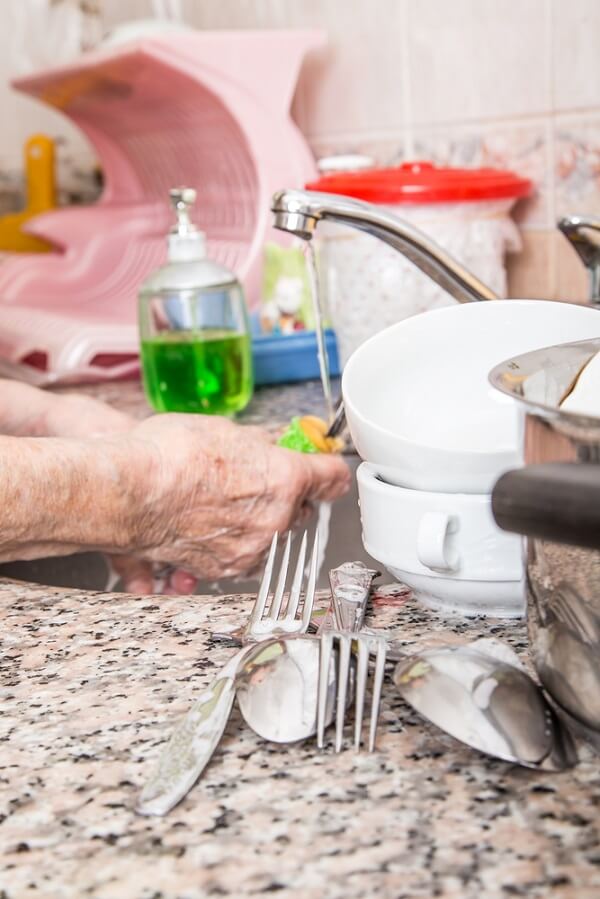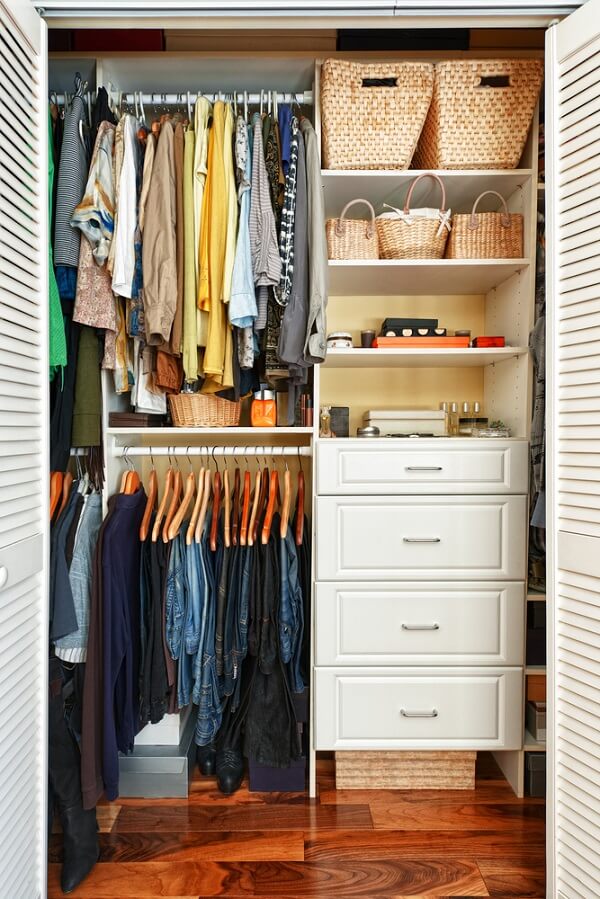Did you know that mess causes stress? According to a study at Princeton University, clutter actually inhibits your brain’s ability to focus. Mess and clutter in the home are major causes of stress amongst adults, with over 80% of men and women recently surveyed indicating that the cleanliness of their home environment caused them anxiety.

According to a UCLA study, just looking at clutter increased female respondents stress levels!
The best way to tackle a whole house declutter is to take it room by room. Now, that doesn’t mean moving clutter from one room to the next room without actually dealing with it; it means tackling each room, top to bottom, inside and out (including drawers, cupboards and under furniture) and dealing with all room associated clutter immediately. Now, you may find errant belongings that should be, say, in the kitchen, while you’re decluttering the dining room. It’s ok to move those items into the kitchen and deal with them when you tackle that room later.
There are three types of ‘clutter’: sentimental clutter, future-use clutter and lazy clutter. Sentimental clutter includes old sports trophies, your childhood teddy bears, every assignment you wrote in high school, photographs waiting for albums and the ticket stubs from your first ever concert. Sentimental clutter is hard to get rid of. Future-use clutter is the slippery slope of accumulation; ‘I’ll just keep this because I may find a use for it one day’. Future-use clutter is common in home offices, craft rooms and garages. It’s why you have 200 odd buttons in a drawer and why you’ve been collecting corks for that ‘unknown’ future project. Lazy clutter is everything else that you don’t find the time or inclination to deal immediately and that begins stacking up in corners and on countertops throughout your home. Old newspapers, magazines, receipts, paid bills and junk mail are all examples of lazy clutter. Luckily, lazy clutter’s pretty easy to toss out; you just need to allocate time and motivation to the purge.
From the outset, you’ll need to be brutal. Decluttering doesn’t mean shifting that pile of old magazine from one room to the next, it means tossing it in the bin. Mentally prepare yourself to ditch or donate. Take two boxes and clearly label them ‘Ditch’ and ‘Donate’. As these boxes fill up, periodically take the ‘Ditch’ box out to the rubbish bin to empty it. As your ‘Donate’ box fills up, transfer donations into plastic bags or cardboard boxes and take them straight to the car. At the end of the day, take a trip to your local charity shop deposit depot.

A word on donating: Charity shops love receiving usable items in decent condition. Don’t donate anything that’s overly worn, broken or missing pieces. Make sure items are clean before you bundle them off to the charity shop. If you’re donating big items (like furniture), some charity shops will come and collect it from you; all you need to do is call them to arrange a pickup. Don’t donate rubbish, just bite the bullet and put that stuff in the bin.
How do you know when to ditch, donate or keep? A good rule of thumb is to apply the 12 month test. Have you used/worn/needed or thought about the item in the last twelve months? If the answer is no, toss it out!
Decluttering goes hand in hand with re-organising; you know the saying ‘a place for everything and everything in its place’? Be prepared to re-organise as you declutter.
Kitchens tend to be the centre of our homes but they are also the epicentre of accumulated clutter. Bags get dropped, keys tossed, mail dumped on every conceivable surface. We collect gizmos and gadgets for cooking that we may only use occasionally or never (melon baller anyone?). As you go through your cupboards and drawers, always remember the 12 month test and apply it wherever possible. Here are some helpful kitchen specific hints to keep your kitchen clean and tidy:
Keep countertops clear
Clear your countertops; toss out junk mail, old paperwork, receipts, letters and any other non-essential paper items. Collect and organise pens, scissors and other stationery items into one central location (if required) or relocate them to your home office. Wherever possible, store appliances in drawers or cupboards and leave your countertops clear. Give the fridge door a once over; if you can, keep it completely devoid of any paperwork and magnets. If this isn’t possible, arrange everything as neatly as possible.

Organise your pantry
Don’t just put your groceries away anywhere; organise your pantry so that items are easy to find and are grouped together logically. Put baking items with baking items, spices with spices and cereals with cereals. Go through your pantry and throw out anything that’s past its use-by date. Consolidate ‘leftover’ ingredients (like different types of pasta) into one container. Consider purchasing see-through baskets to store items in.
Clear out the fridge
Once a week, go through your fridge and toss out old food and uneaten leftovers. Once a month you should take everything out and give the shelves a wipe down. Organise your fridge like your pantry, by similar items (e.g. dairy items, meats, sauces, vegetables etc).
Pair your plastics
Everyone has a drawer or cupboard full of plastic storage containers and none of them match. Go through your plastics and try to match up containers with lids. If you have containers without lids or lids without containers, throw them out. Store plastics with containers and lids together.
Use drawer organisers
Use drawer organisers to keep your drawers tidy and your utensils easily accessible.
Use hooks
If your kitchen lacks storage, get yourself some small hooks and use the underside of cupboards, shelves and the inside of doors to maximise storage space. Hang pots and pans, mugs, aprons and tea towels and free up precious cupboard/drawer space.
Bathrooms are busy, multi user spaces. They can get messy quickly. They’re also a hot bed of clutter, so get ready to purge. Start with the cabinets; go through your toiletries and toss out old or almost finished items. You do not need six different hand creams. Throw out old, frayed or stained towels; alternately, many cat and dog shelters take donations of used towels, so check with your local animal rescue centre.

Like your kitchen, only store essential items on the countertop. Organise your drawers and cupboards. Use drawer organisers where necessary. Hang towels instead of storing them folded. Store like items together, so hair care, nail care, body grooming and care, first aid etc. Consider using baskets to keep like items in one contained area.
The home office, otherwise known as the box room, the land of forgotten things, the ‘I’ll deal with it later’ room, always seems to be the room where everything ends up when you’re not quite sure where something goes or you don’t have time to find the right place for it. And then there’s the paperwork. Life’s full of it, even if you try to keep it to a minimum, you’ve probably got paperwork coming out of your ears! Yes, there’s the myth of the paperless office but it’s just that – a myth!

The key to decluttering your home office (and keeping it clutter free) is to organise thoroughly from the outset. So, start culling paperwork. If you don’t need it, chuck it out! Group paperwork into categories: to read, to do and to file.
Keep your desk tops clear (digital and otherwise); only put the items that you use regularly within arm’s reach. Organise books neatly on shelves and donate any books you don’t use or reread regularly to charity.Sort out your drawers; group like stationery items together in one place so that there’s one spot for rubber bands, one spot for paperclips, one spot for pens etc.
Bedrooms are often a nightmare of clutter, made up predominantly of clothes, shoes and accessories. Get ready to cull your wardrobe to make way for a more zen, clutter free boudoir.

Organise. Organise. Organise. Use under the bed storage for shoes, scarves and jumpers. Arrange clothes in your closet and drawers by category (jeans, t-shirts, work shirts, skirts etc). Use baskets or bins to organise small items like jewellery, socks and belts. Put a clothes hamper in your room to put your dirty clothes in at the end of the day. Clear bedside table tops and drawers.Start with your clothes. Apply the 12 month test. Throw away any damaged or frayed items. If you have a pile of ‘mending’ that’s yet to be mended after six months, get rid of it. Throw out your acid washed jeans – they aren’t coming back into fashion – ever. Go through your shoes and accessories; they may be in great condition but if you never use them and they are taking up space, donate them so that someone else can get some use out of them.
Use mesh or plastic boxes to keep children’s toys in check.
Go through your CDs and DVDs; cull if necessary but reorganise them for easy access. Throw out old magazines and newspapers. Sort through bookshelves and donate books you no longer need or wish to re-read. Untangle and smooth out cords for electronics. Fold blankets and place them neatly over the backs of chairs or couches. Clear the coffee table top. Often clutter in the living room is an accumulation of items that actually belong in other rooms, so spend the time to move things to their designated ‘home base’.
Children’s toys are often the main culprit for cluttering up family living rooms. Invest in some mesh or plastic boxes to keep the toys contained and out from underfoot.
Throughout our lives we accumulate lots of ‘stuff’. Make sure your belongings, whether valuable or sentimental, are protected by a suitable home and contents insurance policy. As you declutter each room, take note of the items you are keeping and make sure that everything’s covered on your policy that needs to be covered. Enjoy your clutter-free home!